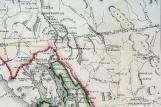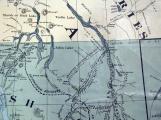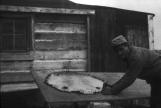1
Inland Tlingit Clans and Moieties
2
Map detail showing Alaska panhandle region, northern British Columbia and southern Yukon, 1901.
1901
Canadian Northwest and Alaska

3
The word "Tlingit" (pronounced Clink-it), which the people call themselves, means "the people". This group lived in an area that stretched along the Pacific coast from Mount St. Elias in the north to Sitka in the south.
4
Map of the Canadian Yukon and Northern Territory of British Columbia, 1897.
1897
Teslin Region

5
The Tlingit people of Teslin originally came into the Teslin Lake drainage area during the 19th century. They came inland from the Pacific coast, specifically the Juneau and southeastern portion of Alaska.
As resources on the coast became depleted, people had to travel inland to find furs for trade with Russians and Europeans.
6
Tlingit beaded dance bag.
2002
Teslin, Yukon

7
For many years, the Inland Tlingit lived a semi-nomadic life. People spent most of the year out on the land hunting, trapping and gathering food. They were also skilled woodcarvers, artists and carpenters.
8
Spruce root carrying baskets and sheephorn spoon.
1951
Teslin, Yukon

9
Before the Tlingit learned to work metal or pot with clay, they wove baskets from spruce roots. The baskets were used as cooking kettles. First, meat or berries were placed in the basket, then hot stones were placed over the meat or berries using wooden tongs. Water was added to create steam. The basket was then covered to let the food cook.
10
Watson Smarch stretching a beaver skin the 'new way.'
1951
Teslin, Yukon

11
The old way to stretch beaver skins was in an oval. Later, skins were stretched in a circular shape.
12
David Johnston with skin boat.
April, 1951
Teslin, Yukon

13
Hide boats were built over wooden frames of almost any size. These frames were similar to those used for canoes. The sides of one to three moosehides were pulled and wrapped around the top rail of the frame, snug but not too taut. The hide boat was then stored in a shady place when not in use.
14
Jim Fox using awl to make hole in snowshoe frame for webbing.
11 July 1949
Teslin Region







